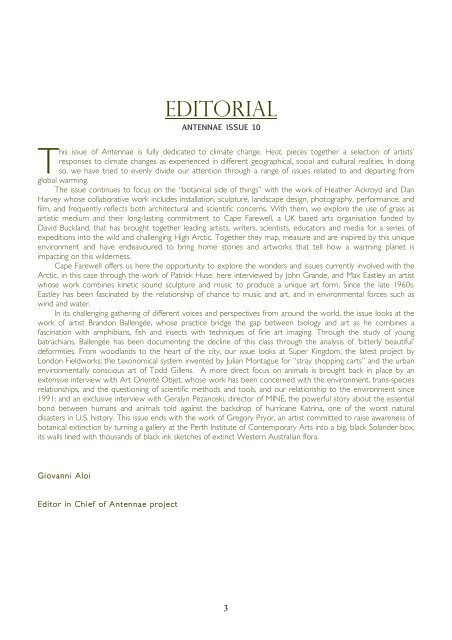M - Antennae The Journal of Nature in Visual Culture
M - Antennae The Journal of Nature in Visual Culture
M - Antennae The Journal of Nature in Visual Culture
You also want an ePaper? Increase the reach of your titles
YUMPU automatically turns print PDFs into web optimized ePapers that Google loves.
T<br />
his issue <strong>of</strong> <strong>Antennae</strong> is fully dedicated to climate change. Heat, pieces together a selection <strong>of</strong> artists’<br />
responses to climate changes as experienced <strong>in</strong> different geographical, social and cultural realities. In do<strong>in</strong>g<br />
so, we have tried to evenly divide our attention through a range <strong>of</strong> issues related to and depart<strong>in</strong>g from<br />
global warm<strong>in</strong>g.<br />
<strong>The</strong> issue cont<strong>in</strong>ues to focus on the “botanical side <strong>of</strong> th<strong>in</strong>gs” with the work <strong>of</strong> Heather Ackroyd and Dan<br />
Harvey whose collaborative work <strong>in</strong>cludes <strong>in</strong>stallation, sculpture, landscape design, photography, performance, and<br />
film, and frequently reflects both architectural and scientific concerns. With them, we explore the use <strong>of</strong> grass as<br />
artistic medium and their long-last<strong>in</strong>g commitment to Cape Farewell, a UK based arts organisation funded by<br />
David Buckland, that has brought together lead<strong>in</strong>g artists, writers, scientists, educators and media for a series <strong>of</strong><br />
expeditions <strong>in</strong>to the wild and challeng<strong>in</strong>g High Arctic. Together they map, measure and are <strong>in</strong>spired by this unique<br />
environment and have endeavoured to br<strong>in</strong>g home stories and artworks that tell how a warm<strong>in</strong>g planet is<br />
impact<strong>in</strong>g on this wilderness.<br />
Cape Farewell <strong>of</strong>fers us here the opportunity to explore the wonders and issues currently <strong>in</strong>volved with the<br />
Arctic, <strong>in</strong> this case through the work <strong>of</strong> Patrick Huse, here <strong>in</strong>terviewed by John Grande, and Max Eastley an artist<br />
whose work comb<strong>in</strong>es k<strong>in</strong>etic sound sculpture and music to produce a unique art form. S<strong>in</strong>ce the late 1960s.<br />
Eastley has been fasc<strong>in</strong>ated by the relationship <strong>of</strong> chance to music and art, and <strong>in</strong> environmental forces such as<br />
w<strong>in</strong>d and water.<br />
In its challeng<strong>in</strong>g gather<strong>in</strong>g <strong>of</strong> different voices and perspectives from around the world, the issue looks at the<br />
work <strong>of</strong> artist Brandon Ballengée, whose practice bridge the gap between biology and art as he comb<strong>in</strong>es a<br />
fasc<strong>in</strong>ation with amphibians, fish and <strong>in</strong>sects with techniques <strong>of</strong> f<strong>in</strong>e art imag<strong>in</strong>g. Through the study <strong>of</strong> young<br />
batrachians, Ballengée has been document<strong>in</strong>g the decl<strong>in</strong>e <strong>of</strong> this class through the analysis <strong>of</strong> ‘bitterly beautiful’<br />
deformities. From woodlands to the heart <strong>of</strong> the city, our issue looks at Super K<strong>in</strong>gdom, the latest project by<br />
London Fieldworks; the taxonomical system <strong>in</strong>vented by Julian Montague for “stray shopp<strong>in</strong>g carts” and the urban<br />
environmentally conscious art <strong>of</strong> Todd Gillens. A more direct focus on animals is brought back <strong>in</strong> place by an<br />
extensive <strong>in</strong>terview with Art Orienté Objet, whose work has been concerned with the environment, trans-species<br />
relationships, and the question<strong>in</strong>g <strong>of</strong> scientific methods and tools, and our relationship to the environment s<strong>in</strong>ce<br />
1991; and an exclusive <strong>in</strong>terview with Geralyn Pezanoski, director <strong>of</strong> MINE, the powerful story about the essential<br />
bond between humans and animals told aga<strong>in</strong>st the backdrop <strong>of</strong> hurricane Katr<strong>in</strong>a, one <strong>of</strong> the worst natural<br />
disasters <strong>in</strong> U.S. history. This issue ends with the work <strong>of</strong> Gregory Pryor, an artist committed to raise awareness <strong>of</strong><br />
botanical ext<strong>in</strong>ction by turn<strong>in</strong>g a gallery at the Perth Institute <strong>of</strong> Contemporary Arts <strong>in</strong>to a big, black Solander box,<br />
its walls l<strong>in</strong>ed with thousands <strong>of</strong> black <strong>in</strong>k sketches <strong>of</strong> ext<strong>in</strong>ct Western Australian flora.<br />
Giovanni Aloi<br />
Editor <strong>in</strong> Chief <strong>of</strong> <strong>Antennae</strong> project<br />
EDITORIAL<br />
ANTENNAE ISSUE 10<br />
3












